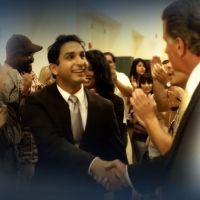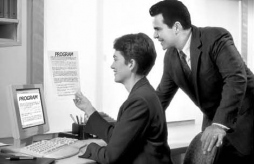There is another basic element of public relations that is often overlooked and given far too little importance, but when applied correctly can give one a foundation for success in dealing with others.
The original procedure developed by man to oil the machinery of human relationships was “good manners.”
Various other terms that describe this procedure are politeness,
Even the most primitive cultures had highly developed
Throughout all races, “bad manners” are condemned.
Those with “bad manners” are rejected.
Thus the primary technology of public relations was “manners.”
Therefore, a person or team of people applying the techniques of public relations who have not drilled and mastered the manners accepted as “good manners” by those being contacted will fail. Such a person or team may know all the senior PR technology and yet fail miserably on the sole basis of “exhibiting bad manners.”
“Good manners” sum up to:
(a) granting importance to the other person and
(b) using the two-way communication cycle.
In dealing with people, it is impossible to get one’s ideas across and gain any acceptance without a two-way communication cycle.
By “cycle” is meant a span of time with a beginning and an end. In a cycle of communication we have one person originating a communication to a second person who receives the communication, understands it and
Whatever motions or rituals there are, these two factors—granting importance to the other person, and using the two-way communication cycle—are involved. Thus a person violating them will find himself and his program rejected.
Arrogance and force may win
For all his “mental technology” the psychiatrist or psychologist could never win applause or general goodwill because they are personally (a) arrogant beyond belief (b) hold others in
They just don’t have “good manners”; i.e., they do not (a) consider or give others a feeling of importance and (b) they are total strangers to a communication cycle.
Successful PR
All successful public relations, then, is built upon the bedrock of good manners, as these are the first technology developed to ease human relations.
Good manners are much more widely known and respected than public relations technology. Therefore no public relations technology will be successful if this element is omitted.
Brushing off “mere guards” as beneath one’s notice while one goes after a contact with their boss can be fatal. Who talks to their boss? These “mere guards.”
Making an appointment and not keeping it, issuing an invitation too late for it to be accepted, not offering food or a drink, not standing up when a lady or important man enters, treating one’s subordinates like
As public relations is basically acceptance then bad manners defeat it utterly.
To apply the techniques of PR successfully, a person has to have good manners.
This is not hard. One has to assess his attitude toward others and iron it out. Are they individually important? And then he has to have his two-way communication cycle so perfect and natural, it is never noticed.
Given those two things, a person can now learn the bits of ritual that go to make up the procedure that is considered “good manners” in the group with which he is associating.
Then given public relations technology correctly used, one has successful PR.
Importance
You have no idea how important people are. There is a reversed
Ignore people
Flattery is not very useful, is often suspect, as it does not come from a sincere belief and the falsity in it is detectable to all but a fool.
A person’s importance is made evident to him by showing him respect, or just by assuring him he is visible and acceptable.
To see and acknowledge the existence of someone is a granting of their importance.
To know their name and their connections also establishes importance.
Asserting one’s own importance is about as acceptable as a dead cat at a wedding.
People have value and are important. Big or small they are important.
If you know that, you are
Thus public relations can occur.
Communication
The two-way communication cycle is more important than the content.
The content of the communication, the meaning to be put across to another or others, is secondary to the fact of a two-way communication cycle.
Communication exists to be replied to or used.
Communication, with the communication cycle present first, must exist before it carries any message.
Messages do not travel on no
Advertising is always violating this. “Buy
A funny example was a salesman who without preamble or reason wrote to people and told them to buy a multithousand-dollar product without even an explanation of its use or value. Response zero. No communication line. He was writing to a name but not really to anyone.
In social
Good manners require a two-way communication cycle. This is even true of social letters and phone calls.
Out of this one gets “telling the hostess good night as one leaves.”
One really has to understand the two-way communication cycle to have really good manners.
Without a two-way communication cycle, public relations is pretty poor stuff.
Rituals
If an American Indian’s ritual of conference was so exact and complex, if a thousand other primitive races had precise social conduct and forms of address, then it is not too much to ask modern man to have good manners as well.
But “good manners” are less apparent in our times than they once were. This comes about because the intermingling of so many races and customs have tended to destroy the ritual patterns once well established in the smaller units.
So one appears to behold a sloppy age of manners.
This is no excuse to have bad manners.
One can have excellent manners by just observing:
a. Importance of people
b. Two-way communication cycle
c. Local rituals observed as proper conduct
These are the first musts of someone applying PR technology.
On that foundation can be built an acceptable public relations presence that makes PR succeed.
PR TECHNOLOGY HELPS YOU MAKE A BETTER WORLD |
|
fitting or proper behavior, what is in accordance with good breeding; the avoidance of anything offensive in manner.
the formal rules for polite behavior in society or in a particular group.
1. the process of improving something and making it more effective by removing what is considered imperfect while inserting better elements. 2. elegance of feeling, taste, manners, language, etc.
refinement, especially of style, that is the mark of expertise or experience.
the state or condition of being courtly, showing great delicacy and refinement in behavior.
a set of fixed actions and sometimes words performed regularly, especially as part of a religious ceremony or social custom.
ability or power of controlling something.
bitterly severe.
a servant of low rank.
the corresponding relationship between two or more things; proportional relation. A ratio is sometimes expressed as a number or amount in relationship to another number or amount. For example, if a person spends ten hours inside and one hour outside, the ratio is 10:1 or ten to one.
a woman employed to clean a house or office.
accepting the responsibility or risks of whatever consequences may result, especially from one’s actions in disregarding or disobeying someone or something, a phrase used especially in warnings or commands.
partway to the intended goal or accomplishment one has set out to achieve.
the route along which a communication travels from one person to another.
a made-up name.
communication or exchanges between people or groups, especially conversation or social activity.










